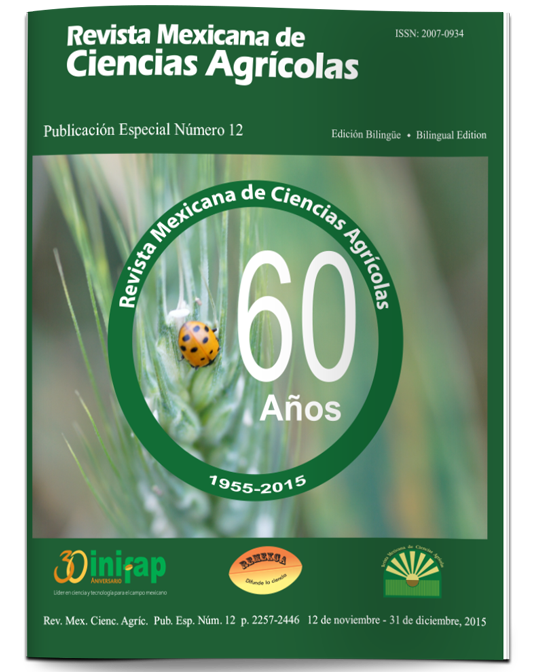Fertilización biológica del cultivo de maíz
DOI:
https://doi.org/10.29312/remexca.v0i12.770Keywords:
Zea mays L., algas marinas, contenido relativo de clorofila, tasa de transporte de electronesAbstract
Por la creciente demanda de productos agrícolas y el incremento en los costos de los fertilizantes químicos, asociado a la contaminación que éstos pueden ocasionar al medio ambiente, es necesario desarrollar otras alternativas sustentables para la producción agrícola. Con la bofertilización, se podrían mitigar estos problemas, y a su vez incrementar el rendimiento de los cultivos. El objetivo de este estudio fue evaluar el efecto de la aplicación de fertilizantes biológicos derivados de algas marinas aplicados al suelo y al follaje en un maíz forrajero (Zea mays L.). Las variables de respuesta fueron: contenido relativo de clorofila, tasa de transporte de electrones, altura de planta, diámetro del tallo y peso seco de la planta. La investigación se realizó durante el ciclo verano-otoño 2011 en Torreón, Coahuila, México. Se evaluaron dos tratamientos. Con y Sin fertilizantes biológicos, Los fertilizantes derivados de extractos de algas marinas aplicados fueron: 1 L ha-1 del compuestoAlgaenzimsMRy0.5Lha-1 deAlZincBMR.Eldiseño fue completamente al azar. Cada tratamiento se repitió 10 veces. Las plantas que recibieron fertilización biológica mostraron valores mayores (p≤ 0.05) de contenido relativo de clorofila (32.4%) y tasa de transporte de electrones (17.8%), que resultó en un incremento (p≤ 0.05) en: altura de planta (17.3%), diámetro de tallo (10.5%) y peso seco de planta (14.8%) respecto a las plantas sin aplicación de fertilizantes biológicos.
Downloads
Downloads
Published
How to Cite
Issue
Section
License
The authors who publish in Revista Mexicana de Ciencias Agrícolas accept the following conditions:
In accordance with copyright laws, Revista Mexicana de Ciencias Agrícolas recognizes and respects the authors’ moral right and ownership of property rights which will be transferred to the journal for dissemination in open access. Invariably, all the authors have to sign a letter of transfer of property rights and of originality of the article to Instituto Nacional de Investigaciones Forestales, Agrícolas y Pecuarias (INIFAP) [National Institute of Forestry, Agricultural and Livestock Research]. The author(s) must pay a fee for the reception of articles before proceeding to editorial review.
All the texts published by Revista Mexicana de Ciencias Agrícolas —with no exception— are distributed under a Creative Commons License Attribution-NonCommercial 4.0 International (CC BY-NC 4.0), which allows third parties to use the publication as long as the work’s authorship and its first publication in this journal are mentioned.
The author(s) can enter into independent and additional contractual agreements for the nonexclusive distribution of the version of the article published in Revista Mexicana de Ciencias Agrícolas (for example include it into an institutional repository or publish it in a book) as long as it is clearly and explicitly indicated that the work was published for the first time in Revista Mexicana de Ciencias Agrícolas.
For all the above, the authors shall send the Letter-transfer of Property Rights for the first publication duly filled in and signed by the author(s). This form must be sent as a PDF file to: revista_atm@yahoo.com.mx; cienciasagricola@inifap.gob.mx; remexca2017@gmail.
This work is licensed under a Creative Commons Attribution-Noncommercial 4.0 International license.



